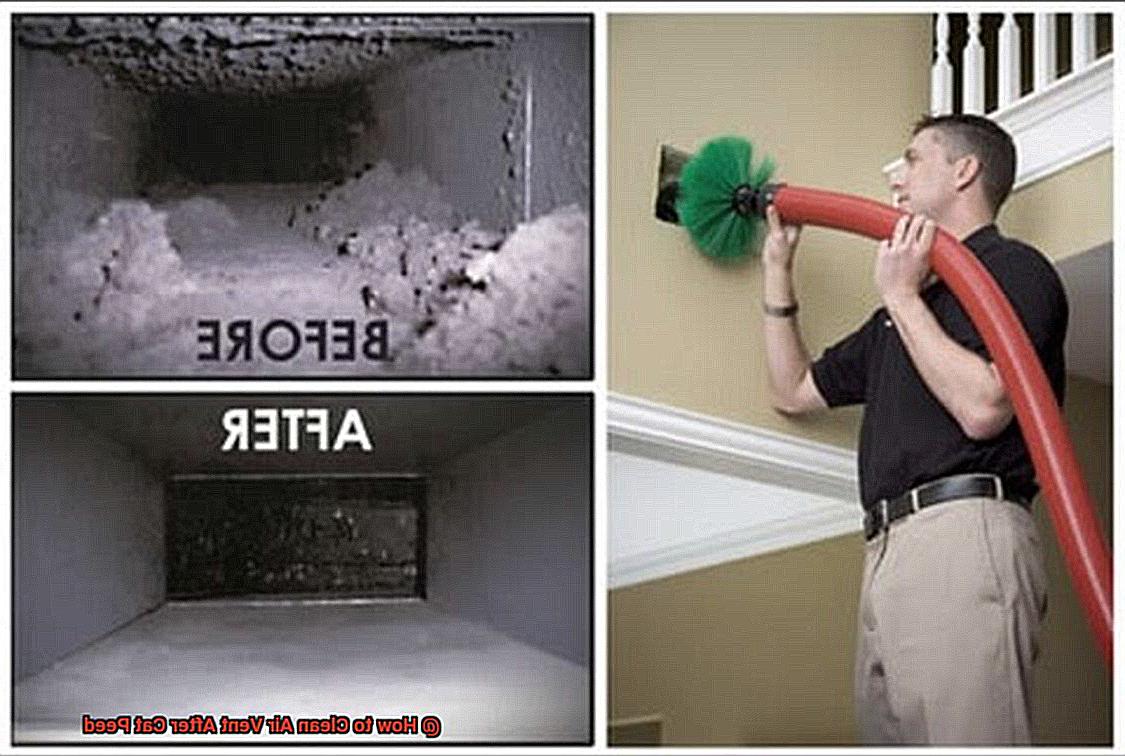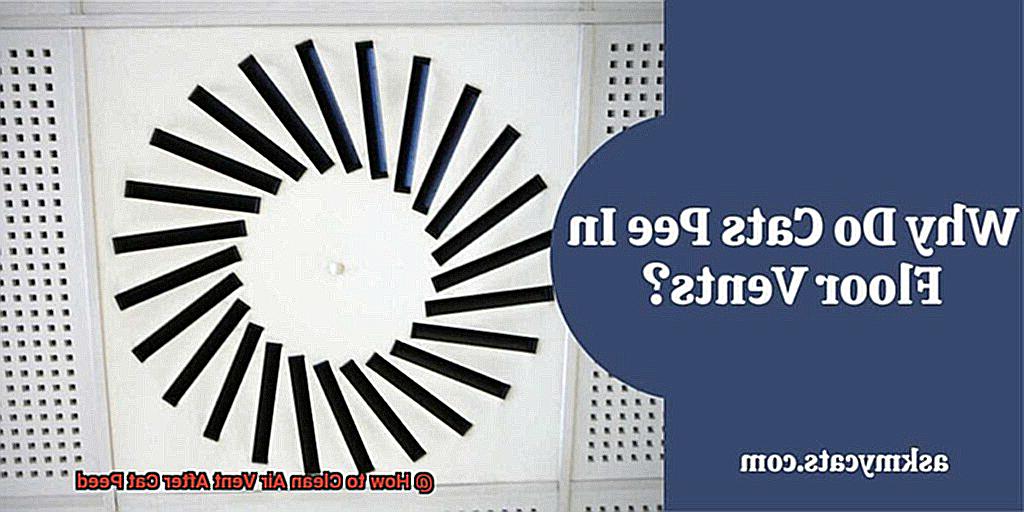Are you stuck with a strong, unmistakable odor? Your cat has peed in your air vent. It’s a difficult job, but don’t worry—we’ve got you covered! In this blog post, we’ll show you how to clean an air vent after cat pee.
We’ll provide the equipment you need and step-by-step instructions on how to get it done quickly and effectively.
So if you want your house to smell fresh again, read our expert advice on how to clean air vents after cat pee.
Why Is My Cat Obsessed With Vents?
Cats are naturally curious creatures, and they love to explore their environment. Vents provide them with warmth, which is why they are often drawn to them. In addition, cats like to hide in dark places, so vents provide them with the perfect hiding spot.
Cats may also be attracted to the smell of other cats in the vents, and they may be trying to mark their territory by peeing in them. Finally, cats may be drawn to vents because it provides a safe haven from predators or loud noises in the home.
Why Do Cats Pee In Floor Vents?
There are several possible explanations for why cats may be drawn to peeing in floor vents. For starters, cats may be attracted to the warmth of the vent or the smell of the air that comes from it.
Additionally, cats are naturally territorial animals, so they may be trying to mark their territory by peeing in the vent.
Stress and anxiety can also cause cats to seek out a safe place to relieve themselves, such as floor vents.
Lastly, cats may find floor vents attractive due to their easy access and difficult clean-up for humans.
If your cat is peeing in your floor vents, it’s important to take steps to address the underlying cause.
If fear or anxiety is an issue, make sure your cat has plenty of outlets for exercise and playtime.
You can also try using pheromone sprays or diffusers around the house if marking territory is a concern.
If all else fails, consider blocking off access to your floor vents with furniture or a pet gate.
How To Stop Cats From Peeing In Floor Vents?
Cats can be mysterious creatures, and unfortunately, one of their more perplexing behaviors is peeing in floor vents. This can be a messy and smelly problem that can cause damage to your household if not addressed promptly. I offer the best ways to prevent this behavior and keep your home smelling fresh in the following:
Understand Cat Behavior
The first step in preventing cats from peeing in floor vents is understanding why they do it. It could be due to stress, anxiety, or territorial marking—all of which require different approaches for prevention.
Make the Area Unattractive
To make the area less attractive to cats, block the vent with a screen or other barrier. You can also use deterrent sprays like citrus or lavender to discourage cats from marking the area.
Provide Positive Reinforcement
Training your cat to use their litter box is also essential for preventing them from peeing in the vents. Provide positive reinforcement when they use it correctly, and make sure their litter box is always accessible and clean.
Reduce Stress Levels
If your cat is peeing in floor vents due to stress, try calming remedies like Feliway or Rescue Remedy to reduce their anxiety levels and make them feel safe and secure again.
Ensure Proper Accessibility
Finally, make sure your cat has access to a litter box so they have an appropriate place for elimination instead of the air vent.
What To Put Over Vents To Prevent Cat From Peeing?
Pet-proof vent covers are the best way to prevent this issue. These covers are made of heavy-duty plastic and come in a variety of sizes that fit most standard floor vents. Installing them is easy, and they provide an effective barrier against cats entering the air ducts.
Another option is to use a piece of furniture or other object to block access to the vent, such as a bookcase or dresser. This will make it difficult for cats to get inside the vent opening and should discourage them from peeing near it.
Mesh screens are also a popular choice for covering vents. They are easy to install and can be removed or replaced as needed. Plus, they’re relatively inexpensive and widely available. However, they may not be as effective as pet-proof vent covers at keeping cats away from the vents, so it’s important to consider this before buying one.

Plastic or metal covers are more permanent solutions that can be installed over the vent to prevent cats from accessing it. These types of covers are more durable than mesh screens and can last for many years if properly cared for.
Finally, some cat owners have had success using double-sided tape around the edge of the vent opening as a deterrent for cats. This creates an unpleasant sensation when they attempt to access the vent and may discourage them from returning in the future.
When deciding which option is best for your situation, it’s important to consider your needs and budget before making a purchase.
Pet-proof vent covers provide an effective barrier against cats entering air ducts without having to use furniture or other furniture to block access; however, they may not always be within everyone’s budget range.
Mesh screens are a cheap alternative that can still keep cats away from vents, but plastic or metal covers offer more durability.
Double-sided tape is another option that some cat owners have had success with, but it is not as effective at keeping cats away from vents as well as other methods mentioned above.
How Do You Get Urine Smell Out Of Floor Vents?
Having a pet can be an incredible experience, but it can also lead to some unwanted odors in your home. If you’re dealing with pet odors coming from your floor vents, don’t despair.
There are several steps you can take to get rid of them. As a student at the University of Reading, I have researched the best ways to remove pet odors from your floor vents.
The first step is to remove any visible urine stains from the vent. Use a damp cloth and a mild detergent to wipe away any residue.

Once the vent is clean, it’s time to tackle the smell. Create a cleaning solution by mixing baking soda, vinegar, and water, and apply it directly to the vent. Let this sit for 10–15 minutes before wiping it off with a clean cloth.
Another option is to use an enzymatic cleaner specifically designed for pet odors. These cleaners are specially formulated to break down and neutralize pet odors, leaving your vents smelling fresh and clean.
If you’re still having issues with lingering smells coming from your vents, try using an air freshener or deodorizer specifically made for pet odors.
These products will help neutralize any remaining smells without having to resort to harsh chemicals or cleaners.
You can quickly get rid of any bad pet odors in your floor vents by following these simple steps!
How to Clean Air Vent After Cat Peed?
If your cat has peed in your air vent, you may be wondering how to clean it. Don’t worry, we’ve got you covered! Follow these simple steps, and you’ll have your air vent clean and odor-free in no time.
First, use a vacuum cleaner to remove as much of the urine and debris as possible. This will help get rid of any large chunks that may have become stuck in the vent piping.
Next, mix up a solution of vinegar and water to clean the vent. This will help neutralize any odors that might be lingering. You can also use an enzymatic cleaner to break down the urine and eliminate any odors that remain.
Once the air vent is clean, apply a sealant or protective coating to it so cats won’t be tempted to pee there again in the future.
Finally, replace any filters that may have been contaminated with urine and make sure they are installed correctly before turning on the air conditioning system again.
Tips for Maintaining Healthy Air Quality in Your Home After Cleaning The Air Vent
Maintaining a healthy home air quality is essential for both your and your family’s health and wellbeing. Cleaning the air vents in your house is a great way to raise the air quality, but there are some additional measures you can take to ensure that your home’s air is fresh and clean.
Here are 8 tips on how to keep your home’s air quality healthy after cleaning the air vent:
Use an Air Purifier
An air purifier can help remove odors, allergens, dust mites, pollen, and other pollutants from the air in your home. This will help improve the overall air quality in your house and reduce any potential health risks.
Vacuum Regularly
Vacuuming regularly helps to remove dust, dander, and other particles suspended in the air before they have a chance to settle into carpets or furniture, which can cause health issues if left unchecked.
Open Windows Occasionally
Allowing fresh air into your household occasionally helps to circulate the stale indoor air that can carry pollutants that can influence your health over time.
Clean or Replace Your Air Filter Regularly
Your HVAC system’s filter should be cleaned or replaced on a regular basis so it continues to function efficiently and effectively. Because a clogged filter is unable to do its job properly, pollute, dirt, and other particles will accumulate in the system and eventually reach your home’s air supply.
Avoid Harsh Chemicals or Fragrances When Cleaning
When it comes to sweeping your house, avoid using harsh chemicals or fragrances, as they may cause health issues for you and your family if inhaled over time. Whenever possible, opt for natural cleaning products, which are safer for both you and the planet.
Use Natural Cleaning Products When Cleaning an Air Vent
Natural cleaning products are safer for both you and the planet because they do not contain any harmful chemicals or toxins that could possibly be released into the air when cleaning an air vent.
They are also more affordable than traditional chemical-based cleaners, so this is a good option if you’re looking for an eco-friendly alternative.
Place House Plants Around Your Home
House plants help filter out toxins in the air while still producing oxygen, which helps improve overall indoor air quality in your home while adding some greenery at the same time.
Install an Exhaust Fan in Bathrooms, Kitchens, and Laundry Rooms: Installing an exhaust fan in bathrooms, kitchens, and laundry rooms helps remove excess moisture from these areas, which can lead to mold growth if left unchecked. Investing in one of these areas is a good idea.
Also Read: How Do Mother Cats Discipline Their Kittens?
Conclusion
Dealing with pet urine odors can be a challenge, but it doesn’t have to be overwhelming. To keep your house free of pet odors, you need to understand why cats are drawn to peeing in floor vents.
Block access to them with furniture or pet-proof vent covers, and give positive reinforcement when they use their litter box correctly.
Finally, use enzymatic cleaners to remove any remaining odors. With patience and persistence, you can keep your house fresh and clean—no more cat pee smell.







